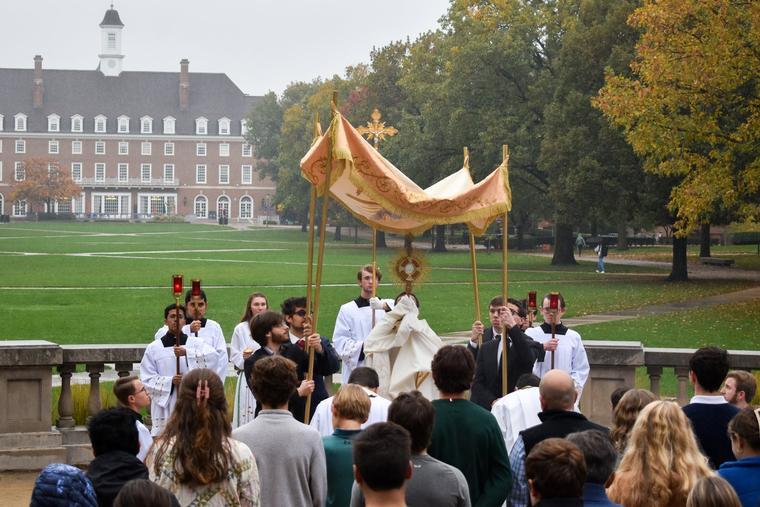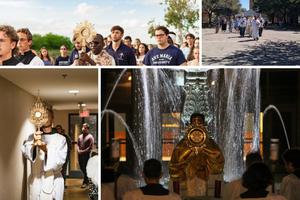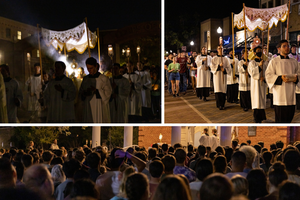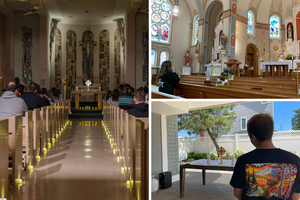Eucharistic Processions on Secular College Campuses Startle Many, Annoy Some … and Intrigue Others
Bringing Jesus to the Masses … Outside of Mass

Father Rob Clements got some interesting comments when he started leading Eucharistic processions at one of his parish assignments in the 1990s.
“You’re a throwback.”
“This isn’t the 1950s.”
“It just feels like we’re going backwards,” one mom of altar boys told him.
But when he became the chaplain at Arizona State University in 2011, he could see a gap in the students’ spiritual life, for which a remedy was needed.
“When I got here, it was a glaring need, because, really, I just think there was a distance in familiarity with Eucharistic adoration,” Father Clements told the Register.
Holding Eucharistic processions has helped, he said.
“It has borne some good fruit; particularly, I would say, piety,” Father Clements said by telephone.
Arizona State is one of several secular colleges in the United States that have implemented periodic Eucharistic processions in recent years. The list includes Columbia University, Vanderbilt University, the University of Illinois, the University of Alabama and Texas A&M, among others.
Kneeling, Objections, Wonderment
At Arizona State, Eucharistic processions take place on the Solemnity of Christ the King in November and on the Solemnity of Corpus Christi in the spring. (Other processions take place on the feast of the Exaltation of the Holy Cross in September and on Palm Sunday.)
One such Eucharistic procession begins after the 4 p.m. Mass at All Saints Catholic Newman Center in Tempe and ends before the 6 p.m. Mass there. It crosses a busy street and a footbridge. Along the way, there are several stops for Benediction at preassembled temporary altars on campus.
There are three types of reactions, said Ben Power, a senior who has participated in them.
One is spontaneous reverence. Some people join in. Father Clements said he has seen people get out of their cars at a stoplight and kneel on the pavement.
Another is negative. Two years ago, an atheist engineering student told the people assembled near an altar outside the engineering dorm that their God is not real, but only a man-made concoction, Power said. Father Clements said a couple of years ago a woman started shouting obscenities. The students started saying the prayer to St. Michael the Archangel, and she took off.
The third type is somewhere in between.
“Intrigue is probably the most common reaction,” Power said. “People cock their heads. They’re kind of mystified by it, in an interesting way, because it’s different from anything they’ve ever seen in their life.”
What Are They?
Christian liturgical processions began in the early Church. St. Basil describes them as “ancient” in a letter he wrote in 388. Specifically, Eucharistic processions likely began in the 13th century, after Pope Urban IV instituted Corpus Christi in 1264.
They fell out of widespread practice after the Second Vatican Council in the 1960s, even though St. Paul VI praised them in his 1965 encyclical Mysterium Fidei, issued near the end of the Council.
They have become a point of emphasis for recent popes.
St. John Paul II promoted Eucharistic processions in his 1980 letter Dominicae Cenae and participated in them as pope.
Why have them?
“What Jesus gave to us in the intimacy of the Upper Room today we express openly, because the love of Christ is not reserved for a few but is destined for all,” Pope Benedict XVI said before a Eucharistic procession in Rome in June 2011 outside the Basilica of St. John Lateran, which is about 2 1/2 miles outside of Vatican City.
Pope Francis spoke in June 2019 at the beginning of a similar Corpus Christi Eucharistic procession outside a church in suburban Rome. He reflected on the account in Luke 9 of the Multiplication of the Loaves and Fishes, which the Church sees as a foreshadowing of the Eucharist, and noted that Jesus tells his disciples: “You give them something to eat.”
He said the Eucharist is meant to be given to others, starting with those who “feel blessed and loved” after having received the Eucharist.
“The Lord comes to our streets in order to speak a blessing for us and to give us courage,” Pope Francis said, with emphasis in the original. “And he asks that we too be blessing and gift for others.”
Jump-Starting an Old Tradition
St. Mary’s Catholic Center at Texas A&M has held Eucharistic processions in October 2021 and in the fall of 2022 and plans to hold another during Easter Week in 2024.
About 700 to 800 students participated in the previous two, said Father Will Straten, the pastor.
“The desire from our staff was to bring Jesus to the place where our students study, live and socialize,” Father Straten said by email.
While most participants prayed the Rosary, about 30 students and staff walked in front, handing out fliers to onlookers on campus, explaining what a Eucharistic procession is and inviting them to join. At the halfway point, at the plaza in front of Memorial Student Center, participants kneeled, sang three hymns, stayed silent for five minutes, and then processed back to St. Mary’s, he said.
The Catholic chaplaincy at the University of Illinois at Urbana-Champaign has also held Eucharistic processions, including last month. Father Robert Lampitt, head chaplain at St. John’s Catholic Newman Center, told the Register he is hoping to have one each semester.

“I think Eucharistic processions accomplish three things,” he said. “First, they provide the faithful the opportunity to publicly manifest their faith and devotion. This may well have been the first such procession for many of our students. Second, it exposes the wider campus to our Catholic belief that Jesus is Lord even of this secular university. He cares for them, loves them and invites them into relationship with him. Third, it is an opportunity to beg God’s blessing upon our university: students, faculty and staff. There is so much pain and woundedness, much of it hidden, that Jesus longs to heal.”

Unexpected Reactions
Columbia University’s Catholic chaplaincy started holding Eucharistic processions on the Solemnities of Christ the King and Corpus Christi last school year. They begin after Sunday Mass at the Church of Notre Dame, which is at the corner of Morningside Drive and West 114th Street in upper Manhattan in New York City, and continue along public streets and into the heart of the campus, known as College Walk.

Though the college began on the grounds of an Episcopal church during the 1750s, Columbia is now a private nonreligious Ivy League school — and has one of the most secular campuses in the country.
The idea of holding a Eucharistic procession on campus at first concerned Karina Magnus, a Catholic student there, who sought reassurance from the chaplain, Father Roger Landry.
She went ahead and participated, taking pictures during the first one and walking in the second. She was surprised by the reaction from onlookers, who saw several dozen people walking with a priest wearing vestments under a canopy holding a bronze monstrance bearing a consecrated Host exposed behind transparent glass and singing hymns.
“Such a secular university, we expected a little bit of backlash. I don’t think we really got that,” Magnus, 21, a senior and biochemistry major, told the Register.
Her Protestant and nonbelieving friends were bewildered by the spectacle and surprised to learn that Catholics believe that a piece of bread consecrated by a Catholic priest during Mass becomes the actual Body and Blood of Jesus and, therefore, God.
But they also expressed admiration for the beauty of the event and the apparent commitment of the people who participated in it. Some said they had thought there were only a handful of Catholics at Columbia.
“They were definitely shocked by the number of people we got to walk around campus with Jesus,” Magnus said. “And a lot of them were more open to it than I expected.”
Joy to the World
Father Landry told the Register the Eucharistic processions last school year increased joy, courage and faith among Catholics at Columbia. He said he has seen an increase in daily Mass attendance, Eucharistic adoration and reverence for the Eucharist.
“One can’t help participate in a Eucharistic procession without growing in one’s awareness that we’re not accompanying a circular piece of unleavened bread,” Father Landry said by email.
It has also assisted bringing Catholic faith outside the church building, by responding to “the practical atheism that underlies secularism, which was defined by Benedict XVI as ‘living as if God doesn’t exist,’” Father Landry said.
“By means of a Eucharistic procession, Catholics publicly proclaim with humble joy that God-with-us is still with us, accompanying us through life and summoning us to follow him,” said Father Landry, who is the founding chaplain of the Thomas Merton Institute for Catholic Life at Columbia (and a Register columnist). “This type of public manifestation of the faith leads ultimately to one of two conclusions: either ‘Those Catholics are crazy, adoring bread as if it is the creator and savior of the world,’ or, ‘Those Catholics seem to be the furthest thing from crazy, and if they all believe that what’s in the monstrance is not bread but God, then perhaps I’m crazy until I join them.’”

Magnus said the processions were important moments in her spiritual life. She is discerning whether to start a doctoral program in biochemistry or to become a campus missionary through Fellowship of Catholic University Students (known as FOCUS) after graduation.
“It was a really amazing and prayerful experience for me, kind of my first time saying, ‘This is my faith, and I’m so proud to express it openly, to anyone,’” Magnus said.
In Communion
Magnus said see now sees such events as vital for Catholic college students.
“Eucharistic processions are so needed on college campuses, because it can be so isolating. It can feel like everyone around you thinks you’re weird,” Magnus said. “And it’s good knowing you’re not alone.”
Likewise, at Arizona State, Father Clements said Eucharistic processions have helped foster a sense of community among Catholic students: “that feeling that they belong, that they connect. That’s so important.”
Power said Eucharistic processions have helped his understanding of the evangelical nature of Catholicism.
“I think, for me, it’s an important reminder of the public witness of my faith: to have that reminder that what Jesus says to me is not just an intellectual truth that I assent to, or what I do on Sunday. It’s my entire life,” said Power, 22, of Scottsdale, Arizona, who has one major that centers on political philosophy and economics and another on Catholic studies and is hoping to teach at a public classical liberal arts charter school after graduation.
“It’s a really good reminder to me not just to be courageous, but to live that joyful life in the world.”














